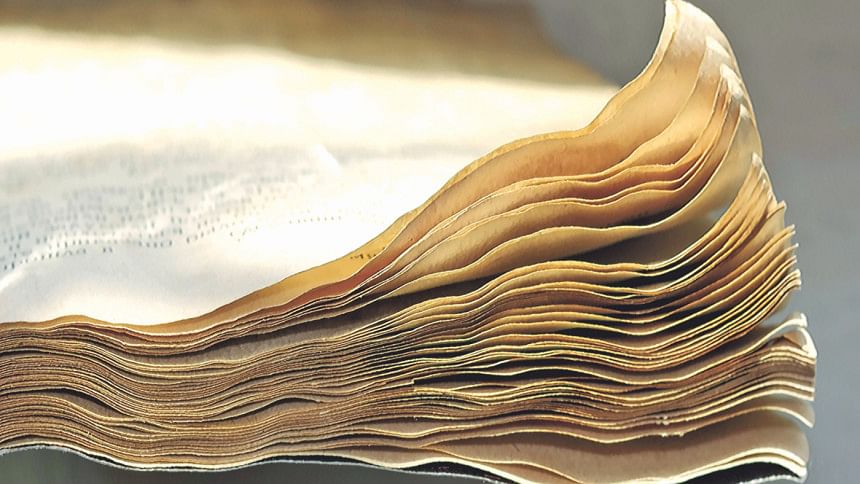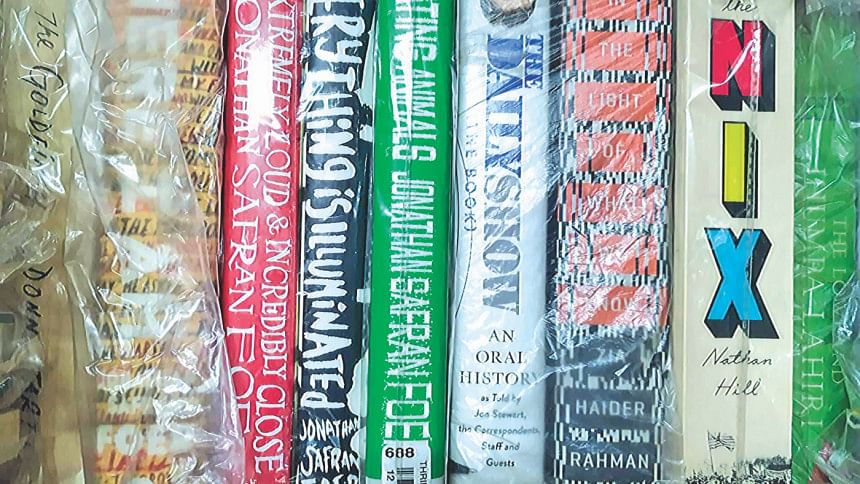How to look after a book

Too often, we perceive books as invincible, inanimate objects. But their history is as ancient as it is ambiguous—what is a book anyway? If it's a writing surface comprising stories and information, then everything from our present-day tablets to pre-historic clay, bone, and wooden tablets, silk scrolls, manuscripts, pottery, and rock and cave etchings should count as different manifestations of a book.
The form most familiar to us dates from the Han dynasty in 2nd century China, where paper was first made from rags being pounded and stirred in water, and then collected on a mat. The raw materials eventually went on to include vegetable fibres and tree bark; the manufacture of bark cloth spread from China through the islands to the Pacific and Central America, and through the Indian Ocean to Central Africa. Printing using wooden blocks dipped in ink was in use in China by 705 CE. According to Eric Marshall White, curator of rare books at Princeton University Library, in his article "Europe's First Printer", the world's earliest surviving book printed with movable type was made in 1377 at the Hungdoksa Temple, Chóngju, Korea.
Meanwhile, in Europe, paper arrived in Italy through Arab Spain in the 12th century; by the 14th century, Italian manufacturers were using animal glue and gelatine instead of vegetable glue as adhesives. The first printed books were appearing in Europe by the mid-15th century, when the Gutenberg printing press was invented. In the 16th century, Christian missionaries hoping to print the Bible in different native languages brought the technology to India, where the first printed Tamil book was produced in Goa.
The book as we know it today is therefore a palimpsest of eras of multitudinous cultural, intellectual, and industrial history, all of which reside in the paper, cover, binding, ink, and even marginalia making up the object. The materials are all vulnerable to a host of invasive elements: biological enemies such as bugs, insects, and human tampering, chemical threats such as fungus and mushroom growth triggered by storage in dark spaces, and other environmental threats including sunlight, heat, water, shocks of light from thunder, and any number of man-made and natural disasters. Implications of the losses resulting from such damage are beyond measure. This is where book conservation and preservation come in—a hugely under-practiced art in Bangladesh.
Conservation in libraries
Alexis Hagadorn, conservator and head of the conservation programme at Columbia University, explains how temperate climates and winter dryness can cause cracking of wooden components, shrinkage of leather and parchment, and flaking of paint layers in books. "But in tropical regions [like Bangladesh], heat and humidity contribute to rapid chemical deterioration, and foster growth of mould and spread of insects that are both quite damaging to collections," she says.
Dr Mezbah-ul-Islam, a professor of Information Science and Library Management at the University of Dhaka, highlights, "Even the metro rail being built close to the DU Library can have adverse effects. Dust and sound pollution from highways and construction work can hamper the physical conditions of old books."
Dr Islam, who is the only one to teach conservation at DU, distinguishes between 'conservation' and 'preservation': the former refers to chemical and physical processes that try to preserve the original physical characteristics of archival documents such as manuscripts, classified records, books, and other artefacts. This might include binding, tissuing, salving, maintaining a register of the artefacts, and repairing damages to the paper or ink. Proper conservation measures prolong the longevity of a book, making it available for future generations of readers and researchers. They also ensure proper utilisation of the funds dedicated to the manufacture and maintenance of books.

Preservation, on the other hand, involves maintaining the library and its artefacts in a usable and durable state, meaning that it both conserves the documents and substitutes and repairs them when needed. Offering proper storage facilities, proper temperature, packing materials, and other necessary environmental conditions would all count as preservation. Alexis Hagadorn explains how even building design can play a role in maintaining stable temperature and relative humidity for such practices. She says, "Sometimes it may be best to look at traditional building methods and housekeeping practices to do this: in tropical climates, for example, buildings designed with good passive air flow have historically kept collections in stable condition, and these structures may provide the most sustainable option, whereas installing expensive air conditioning that may fail could have catastrophic results."
"It is important to have someone inspecting collections regularly, every few days if possible, and looking for signs of infestation and leaking that could lead to water damage and mould growth," Hagadorn adds.
Both the national library and the public university libraries in Bangladesh have basic preservation facilities, according to Dr Islam. A separate binding section is present at the DU library, although not all other libraries have in-house binding and repair facilities. At both DU and the National Library, the books are cleaned, dusted, fumigated, and repaired on the premises. Some books are repaired through Japanese tissues placed between damaged pages (a form of lamination), and some through solvent cleaning, although that is more commonly used on manuscripts. Some artefacts—such as one of the first books by Jalal-addin Rumi, painted with enamel and therefore impervious to water—are processed through aqueous cleaning.
"Each conservation treatment decision has to be made in context." Alexis Hagadorn explains. "What is the book, what parts of it are understood to be important now, how do we think its physical form may become important to readers or scholars in the future. There are often many treatments one could do, so it is important to choose the one that suits the circumstances. In libraries and archives, we like to preserve evidence of past use and provenance, and damage may be part of the history of the object. If an item's damaged state leaves it unsafe to handle, then we would have to address it in some way, because our collections are held so that they can be used by researchers. Working in an institutional conservation lab, one of the benefits as a conservator is the dialogue with curators and sometimes faculty that takes place in selecting the best treatment option with these considerations in mind."
However, Dr Islam stresses that, "There is a serious dearth of modern conservation and preservation practices among those who store, sell, and work with books in Bangladesh. Very few have proper primary and secondary knowledge of how to sustain books."
"No academic institution in Bangladesh has sufficient manpower to ensure proper maintenance of books, neither do they offer proper training or academic education on the same to students. Out of the 45 institutions in Bangladesh, only four universities teach library and information science. Some journalism and mass communication programmes may teach binding and printing. But even among them, conservation and preservation are confined within one or two courses; they are yet to be developed as a separate discipline with well-thought out course outlines."
"There isn't enough leadership and coordination in the field," he insists. "For instance, the Bangladesh National Archives and the National Library, with their huge store of materials, could easily offer training in these topics. DU could be offering more seminars or symposia on the topic. The government could allocate more funding for conservation measures out of its development initiatives, and do a better job of raising public awareness. What we need is access to and free flow of information regarding the conservation of our cultural heritage."
Book preservation at home
Expensive equipment and academic training aren't the only avenues to taking care of books, though. In personal collections across this country and others, book-lovers have found ways to connect emotionally with the inhabitants of their shelves, and to preserve them through easy, inexpensive means.
Minhaz Muhammad, a university student who loves to collect books, has learned how to handle them better from working at Charcha bookstore in Mohammadpur. "Apparently the weather of Bangladesh is not suitable for acid-free paper. So the pages will get yellowed out eventually. One thing that I do now to save them from tanning and edge-wear is plastic wrap the books after I'm done reading them."
"The biggest way I take care of books is in the way I read them," says Susie Chavez, a graduate of history and literature from Columbia University and a former classmate of mine. "Unless they have a lay-flat binding, my book will never be opened all the way. I hold them open at about 70 degrees. When I need more, I pinch the book just past the spine to keep it from cracking. I press curved covers back into shape under other books after I read them, and glue down the edges and corners that—unless you're superhuman or don't take the book anywhere—will never stay perfect."
But not every book is the same. Susie points out how some mass market paperbacks and beach reads are generally meant to be used rather carelessly, or even just once before they fall apart in your hands and into the trash can. Textbooks sit in the library or the classroom, or accompany students through transits and hours of studying and annotating. But even these heavy-duty usages can be economised—books can be positions on the flat side of a school bag, can be pulled out holding the middle of the spine rather than the top, and the curves and twists to the book's shape can be evened out as soon as they occur.
"But you also have your favourite book," Susie points out. "The one someone gave you as a kid and you can't seem to find anywhere; the one that you treat more and more carefully as each reread makes the covers and spine a little weaker. That's the one you want to keep and share with your kids, and you learned to love that book because of the ones your mom, or maybe your grandma, loved as kids. You watched them take these heirlooms down from shelves, lovingly caressing the spine before pulling it and you into their lap to read.
And somehow, knowing how important, how special and loved, that book was to them, it felt special to you. That's a book you're going to keep—even if you hated it—and share with your kids alongside your favourite book. Through love and preservation, that book becomes a vessel through which to tell a different story than the one on its pages; a story generations in the making that, if you, too, can keep it safe, will go on being written long after you."
Sarah Anjum Bari can be reached at [email protected]

 For all latest news, follow The Daily Star's Google News channel.
For all latest news, follow The Daily Star's Google News channel. 



Comments